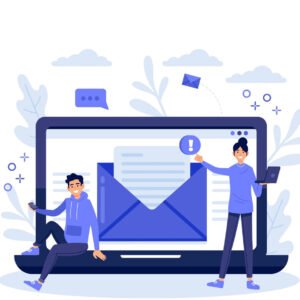
Introduction
Table of Contents
ToggleEmail marketing is still one of the most dependable and economical ways to reach your audience in a time when paid advertisements may quickly deplete your budget and social media algorithms can change overnight.
However, email marketing nowadays involves more than just sending newsletters; it also involves automation, personalization, and astute targeting. When done correctly, email automation may automatically increase conversions, cultivate leads, and foster brand loyalty.
We’ll go into great detail in this book on the reasons email marketing is still important, how automation is changing the landscape, and practical tactics to optimize outcomes in 2025.
Why Email Marketing Still Matters
Some marketers claim “email is dead,” but the data tells a different story:
- 4.4 billion people will be using email by 2025 (Statista).
- Email marketing generates an average ROI of 3,152.78 for every 87.58 spent (Litmus).
- Unlike social media, you own your email list no algorithms or platform shutdowns can take it away.
Email remains a direct channel to your audience’s inbox, where your message isn’t competing with dozens of cat videos or trending memes (unless you put them there).
The Power of Email Automation
Traditional email marketing required you to manually send campaigns time-consuming and inefficient. Automation changes that.
Email automation lets you set up a series of messages triggered by specific actions, like:
- A new subscriber joining your list.
- A customer abandoning their shopping cart.
- A user downloading a free eBook.
- A client reaching their subscription renewal date.
This way, your emails go out at the right time, to the right person, with the right message without you lifting a finger after setup.
Benefits of Email Automation
1. Saves Time
Instead of sending individual emails to every lead or customer, automation lets you build once and run forever.
2. Delivers Personalized Experiences
Automated systems can segment users based on behavior, demographics, or past purchases, so every message feels tailor-made.
3. Improves Conversion Rates
Emails triggered by user actions (like cart abandonment reminders) have much higher open and click-through rates.
4. Strengthens Customer Relationships
Consistent, relevant communication builds trust and keeps your brand top of mind.
Key Types of Automated Emails
If you’re new to automation, here are the most effective types to set up first:
- Welcome Series
- First impressions matter. Send a friendly greeting, introduce your brand, and provide value right away.
- Cart Abandonment Emails
- Remind customers what they left behind and offer an incentive to complete their purchase.
- Post-Purchase Follow-Up
- Thank customers, suggest complementary products, and ask for reviews.
- Re-Engagement Campaigns
- Win back inactive subscribers with a special offer or updated content.
- Lead Nurturing Sequences
- Educate and guide prospects through the sales funnel until they’re ready to buy.
Step-by-Step: Setting Up Email Marketing Automation
Step 1: Choose the Right Email Marketing Platform
Popular automation-friendly platforms include:
Step 2: Build and Segment Your Email List
The strength of your email marketing depends on your list quality. Use:
- Lead magnets (free eBooks, webinars, checklists) to attract sign-ups.
- Sign-up forms on your website, blog, and social media.
- Segmentation to group subscribers based on interests, behavior, or purchase history.
Step 3: Map Out Your Automation Workflow
Plan the trigger events (what causes the email to send) and email sequences (what’s sent and when).
Example:
- Trigger: User signs up for newsletter.
- Email 1 (Day 0): Welcome & thank you + free resource.
- Email 2 (Day 2): Brand story & mission.
- Email 3 (Day 5): Top 3 tips or product recommendations.
Step 4: Write Compelling Email Copy
Tips for high-performing emails:
- Use clear, benefit-driven subject lines.
- Keep content concise but valuable.
- Include a single clear call-to-action (CTA) per email.
- Personalize with the subscriber’s name or location.
Step 5: Test & Optimize
- A/B test subject lines, send times, and CTAs.
- Track metrics: open rate, click-through rate (CTR), conversion rate, unsubscribe rate.
- Adjust sequences based on performance data.
Best Practices for Email Marketing in 2025
- Prioritize Mobile Optimization
Over 60% of emails are opened on mobile devices make sure your design is responsive. - Leverage AI for Personalization
AI tools can recommend products, send dynamic content, and predict the best send times. - Keep It Human
Automation is powerful, but avoid sounding robotic. Add personality, humor, and authenticity. - Stay Compliant
Follow email regulations like GDPR and CAN-SPAM always include an unsubscribe option. - Focus on Value Over Sales
If every email is a sales pitch, subscribers will tune out. Balance promotional and educational content.
Common Email Automation Mistakes to Avoid
- Sending too many emails too quickly (can lead to spam complaints).
- Forgetting to update old automation sequences.
- Ignoring inactive subscribers (clean your list regularly).
- Not testing on multiple devices before launching.
The Future of Email Marketing & Automation
In 2025 and beyond, email automation will get even smarter:
- Hyper-personalized experiences using real-time behavior data.
- Predictive analytics to send the right message before a user even knows they need it.
- Interactive emails with polls, quizzes, and in-email shopping experiences.
Marketers who embrace these innovations while staying authentic will stand out in crowded inboxes.
Conclusion
In the digital age, email marketing and automation are more than simply “nice-to-have” tools; they are necessary for long-term company growth. Campaigns that consistently increase engagement and revenue may be made by combining a sound plan, the appropriate tools, and a customer-first mentality.
Keep in mind that sending better emails is the aim, not sending more.
Begin modestly, test frequently, and continue to improve. You’ll eventually have a completely automated system that turns subscribers into devoted clients and works for you around the clock.
